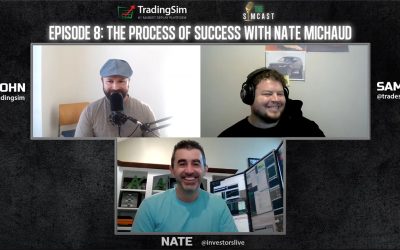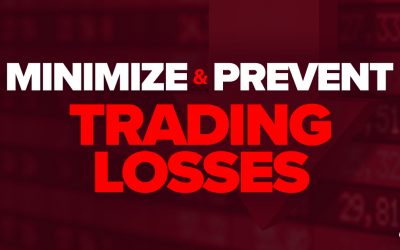Trade management is an important part of the trading process.
It’s not enough to have an effective strategy – you also need to execute that strategy properly.
Think of this distinction as the difference between creating a well-rounded business plan and actually running a successful business. The business plan exists on paper. It’s there to guide you. But, as any business owner knows, creating a plan and executing that plan can be very different.
In trading, your “strategy” is your business plan, and your “trade management” process is your execution of that plan. In order to succeed as a trader, you need to be proficient in both planning and executing.
Here are a few things you should consider when managing your trades.
You Need a Plan Before the Trade
First things first, every successful trade starts with a plan.
If you enter positions without a game plan, you are a gambler, not a day trader.
Before entering a trade, make sure you have a well-rounded game plan. Some considerations include:
- Why are you entering this trade?
- What is your ideal entry point?
- What is your profit target?
- What is your stop loss?
We can’t control the markets, but we can mitigate risk by having a plan for how we are going to react to different scenarios.
View this post on Instagram
Stick to the Plan
Once you have a plan, stick to it.
For example, if you enter a trade at $5 with a $5.50 profit target and a $4.85 stop loss, there should be no uncertainty in the trading process. You know exactly where you are going to sell, whether that results in a profit or a loss. The work is already done.
View this post on Instagram
Be Confident in Your Trading Plan
If you create a well-rounded trading plan, don’t start questioning yourself. Remember the tip above – stick to your plan.
It’s easy to start questioning yourself as emotions creep into the trade, but this is counterproductive.
Be confident in your plan.
A great plan doesn’t necessarily result in a profitable trade, but that’s okay. That’s part of the plan. Great plans account for both success and failure
If you are not confident in your trade plan, then you may need to revisit your planning process to determine the viability of your strategy.
View this post on Instagram
Don’t Trade Just to Trade
Traders don’t get paid based on the number of trades they place, nor do they get paid by the hour.
Your “salary” is directly correlated with the quality of your trades.
Don’t trade for the sake of it. Find the best opportunities and capitalize on them.
No opportunities? Wait. Simple as that.
No trade (i.e. breaking even) is better than a bad trade (i.e. losing money).
View this post on Instagram
Let the Trade Come to You
There’s never a reason to rush a trade.
As traders, we react to price action. We anticipate moves, but we do not let our biases impact our trading activity.
For example, you may find a great setup for an upcoming short trade. You identify a stock that is over-extended and primed for a breakdown. You prepare a plan. What next?
Timing is key. You wait for your trigger to hit before initiating your short position. You don’t force the trade – you let it come to you.
View this post on Instagram
Be Patient and Prepared With Entries
You’ve probably noticed a theme in these tips for trade management. Planning makes the trade management process much easier.
Once you have a plan, you just need to execute it.
Of course, timing is key, and if you want to be successful, you need to be patient.
A great plan can be ruined by bad timing. Enter a position too early or too late, and the plan is useless.
When you create a trade plan, make sure you account for timing. You’ve identified a great setup – what is the trigger for an entry? Until your trigger hits, your job is to be patient and wait for your entry.
View this post on Instagram
Don’t Worry About “Shoulda Coulda Woulda”
Day traders are forward-looking.
You make money by predicting what is going to happen not what already happened. Hindsight is 20/20 (but it doesn’t offer a paycheck).
Don’t start thinking about what you “shoulda coulda woulda” done after you see how a trade plays out.
For example, you may enter a position at $5 with a planned profit target of $6. You exit at $6 for a $1 profit and see that the stock continues running to $10. You start thinking about all of that money you could have made and now you are in an emotional state where you may mismanage a future trade.
Don’t dwell on past trades.
Your job is to plan a trade, execute the trade, and move on to the next one.
Use historical data to improve your strategy, but don’t dwell on how a trade could have panned out differently.
View this post on Instagram
Sometimes More Information is Too Much
Have you ever seen a trader share a chart with dozens of technical indicators?
How do they make decisions?
They don’t…
Traders need to be informed, but too much information can be a bad thing.
The RSI says buy, but the MACD says sell, but VWAP’s telling me to phone a friend…
The same goes for non-technical influences in trading.
If you consider too many scenarios, you will experience decision fatigue and hit a wall.
Focus on the information that is relevant to your decision-making process.
A great trading strategy is one that makes decision-making easier, not harder.
View this post on Instagram
Don’t Make Trades Emotional
One of the biggest differences between planning a trade and executing a trade is emotion.
A plan is theoretical. Execution is very real (especially when your money is on the line).
This is why it’s a lot easier to paper trade than it is to trade with real money. There are no emotions involved in paper trading because the stakes are low.
In real trading, emotions creep in as you watch your account balance fluctuate (for better or worse).
How do you combat this?
Proper planning…
Create plans that you can actually execute.
For example, if you buy 1,000 shares of a stock at $5 with a planned stop loss at $4, can you actually stomach a $1,000 loss? If not, you need to create a more realistic plan.
View this post on Instagram
Protect Your Capital
As a trader, your first responsibility is to protect your capital.
Without capital, you can’t trade.
While profit maximization and risk mitigation are both essential components of trading, risk mitigation is the more important of the two.
If you blow up your account, there won’t be any capital left to maximize profits.
When in doubt, protect your capital.
View this post on Instagram
Define Your Max Stop Loss
So far, we’ve stressed the importance of planning ad nauseam.
Proper planning solves most problems related to trade management.
That said, traders are humans, and humans make mistakes. Even the most disciplined trader has strayed from a plan at one point.
What do you do when you find yourself in deep waters after ignoring a stop loss?
Activate your failsafe.
Set a maximum dollar stop loss and cut a position whenever it hits.
This number should be a number that hurts but enables you to trade another day.
For example, if your typical risk on a trade is $1,000, you may define a maximum risk of $5,000. This becomes your unbreakable trading rule. If you are EVER down $5,000, you sell right away. No rationalizations!
Activating your maximum dollar stop loss hurts, but the alternative is much worse. Nobody plans to blow up a trading account. They just let a bad loss get out of hand. $1,000 turns to $5,000, then $10,000 then – POOF! all of your capital is gone.
View this post on Instagram
Be a Good Loser
Successful traders are not always right.
In fact, most successful traders take losses regularly.
Losing is part of trading. Accept it.
Successful trading is not about “always being right” (i.e no losing trades).
Successful trading is about maximizing profits on winning trades and minimizing losses on losing trades.
Get in the habit of accepting losses as part of the game. Losses are just the cost of doing business.
View this post on Instagram
Consider the Opportunity Cost of Staying in Bad Trades
Bad trades can be two costly in two ways.
The first is obvious – a bad trade results in a loss.
The second is opportunity cost.
When you are focused on managing a bad trade, you are NOT focused on managing a good trade.
While you’re fighting that losing trade and hoping to minimize the loss, you are also neglecting other trades that could result in profits.
Remember the tip above – be a good loser. Accept losing. Get out of bad trades quickly so you can shift your focus back to the trades that make you money.
View this post on Instagram
Don’t Try to Catch the Full Move
What’s your first thought when you see a stock has moved from $5 to $50 in a few days?
Do you start doing the math?
“If I bought 1,000 shares, I could have made $45,000 in a few days.”
Checks out, right?
Wrong.
Riding a stock from the exact bottom to the exact top is HIGHLY improbable. Even worse, this ambition would cause you to trade recklessly. You would aim to time tops and bottoms with a level of precision that is near impossible.
This approach is reckless, foolish, and a complete waste of time.
You don’t need to catch the entire move to make money. There’s plenty of money to be made by capturing the meat of the move.
Follow the trend and capitalize on the trades with the highest probability of panning out in your favor.
Over time, this will pay much better than trying to time black swan moves.
View this post on Instagram
Focus on the Big Picture View
It’s easy to get caught up in the “micro” view of the markets and forget about the “macro” – the bigger picture.
This is an easy trap to fall for when you’re staring at a screen filled with flashing numbers all day.
You start getting caught up in the minutiae of the markets and enter “tunnel vision” mode.
You start over-trading or scalping trades for a few cents here and there.
Don’t miss the forest for the trees.
In the previous tip, we talked about trying to capture the “meat of the move” instead of capturing the full move. The recommendation here is the same (but from a different angle) – capitalize on the meat of the move.
While you shouldn’t try to capture the entire move, you also shouldn’t get so focused on the small trades that you miss the bigger trades.
View this post on Instagram
More Tips
Want more quick trading tips? Make sure to follow on Instagram, Twitter, and Youtube for daily video tips.








As the PPT or whomever bounces these market around the idea of understanding fundamental forces becomes impossible. Many days it seems the markets are controlled in reverse logic. Your
trading approach seems to work despite the enormous insider controls.